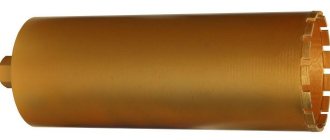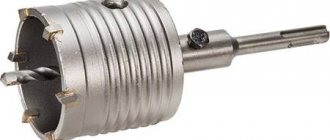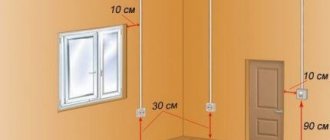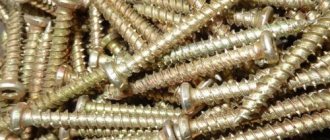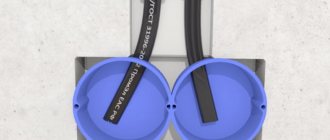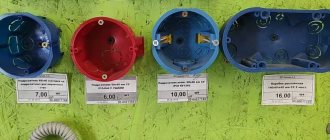In modern electrical engineering, mounting or installation boxes, also known as socket boxes, are widely used. The socket mechanism is fixed inside them when hidden wiring is laid. Most often they are produced round with a certain range of standard sizes. The diameter of the socket box is of great importance, on which the rigidity and reliability of the fastening inside the wall depends. This parameter is tied not only to the outlet, but also to the mounting hole where it will be installed.
Socket boxes and their classification
Before proceeding to the immediate topic of our article, it is necessary to clearly understand what a socket box is, an object for the installation of which a core drill is used. Everyone has a lot of sockets in their home, but they are not just the decorative overlay that we see on the wall. Underneath it lies a terminal block for connections with electrical wiring hidden in the wall (when installing wiring in a wooden house, it is recommended to use surface wiring rather than hidden wiring). It has certain overall dimensions in diametrical terms and in depth. They are the ones who determine the parameters of the socket box, which affect the characteristics of the crown.
Each manufacturer of socket boxes offers its own solutions, but all of them, as a rule, have a round cross-section and are adjusted to the current standard. The wall material (concrete, plasterboard, wood, etc.) determines some of the characteristic design features of socket boxes, as well as their classification.
All socket boxes can be divided into three groups:
- Mounting blocks for concrete. This is a round plastic glass that does not have any elements for fixation (it sits on the gypsum solution in the recess).
- Mounting blocks for plasterboard, plastic. These are almost the same glasses made of plastic, only with additional pressure plates for fixation on the back side of the sheet.
- Mounting blocks for wood. They are a round metal glass (defined by fire safety standards). Used when installing hidden wiring in wood. Adapted for installation in old panel structures.
How to make a hole in a tile for a socket
Using plugs to protect against intrusion into an outlet
It is better to cut a hole in the tile before gluing it to the wall, pressing it firmly against the board placed under it. This is done for two reasons:
- It is difficult to lay a wire behind the glued tiles. The exception is when the outlet is located in the top row of tiles;
- Ceramic tiles are fragile, so drilling in them is only possible with a drill in the “rotation without impact” mode, and only plasterboard and alabaster partitions can be drilled in this way.
Therefore, it is necessary to accurately mark the centers of the boxes in the wall and in the tiles, taking into account the gaps between the tiles. In addition to calculations, you can do the following:
- start drilling the tiles;
- after a through hole appears, attach the tile to the installation site;
- make a mark on the wall through it;
- drill a recess to install the mounting box;
- finish cutting the hole in the tile;
- glue the tiles to the wall and install the mounting box.
Or simply cut out a hole of a larger diameter and fill the gaps with putty.
How to make a hole in a tile
Advice. The sockets and switches are square (double sockets are rectangular), so if they are in the corner of the tile, you can use an angle grinder to make a square cut. Subsequently, it will be closed with a decorative lid.
Knowing how to correctly cut a slot for an outlet and what tool to use is necessary when installing electrical wiring.
What is a crown?
A crown for socket boxes is a special hollow drill that allows you to quickly and economically make large-diameter holes. The size of the drill we are used to is largely limited by the maximum mounting diameter of the tool (drill, hammer drill). There are, of course, drills whose working surface diameter is larger, but these proportions do not go beyond normal ergonomics, cost-effectiveness and efficiency of drilling, and durability of the rod. In order to drill a hole of about 68-70 mm (standard mounting size for a socket box) in wood, and even more so in brick, you need a specially shaped drill bit.
Types of crowns
A crown is a cylindrical composite drill, the end of which contains a cutting edge. Since this is a prefabricated tool, in its central part there is a regular drill (adapted for working with wall material), which first cuts into the wall and centers the main cutting edge.
The classification of crowns occurs according to the type and design of the cutting edge, design dimensions, as well as the material with which they have to work. Thus, it is possible to separate crowns for hard materials (concrete, brick) and softer or more pliable ones (wood, drywall, plastic, etc.).
General description of the tool
For sockets or plumbing pipes, the formation of recesses or through holes of relatively large diameter is required. In this case, you can work with a conventional drill in two ways. If you take a nozzle of the right size, they will have to destroy a large volume of material. Such a decision is not relevant for any reason. The second option is to make several small holes around the circumference. In this case, the walls of the opening turn out to be sloppy, and the middle has to be knocked out. That is, this approach also cannot be called simple and productive.
To solve the task, a crown for socket boxes is one of the most effective tools. Nozzles for working with hard materials are represented by three working elements:
- base with two different tips: a shank for fixing the nozzle in the power tool chuck and a protrusion with an external thread for securing the cutting part;
- a conical or cylindrical centering drill to hold the equipment while working in the exact place and the right direction;
- a drill in the shape of a hollow bowl with a threaded hole at the bottom for fixing to the base of the nozzle and a cutting edge.
An example of a crown in disassembled form Source 220-volt.ru
The main advantage of using a crown for a concrete socket is that the tool contacts only in two places during drilling. A small diameter drill forms a small hole, and the bowl creates a thin strip around the circumference. This makes it possible to relatively quickly create a seat for an installation box or make a through hole in a particular structure.
Characteristics of crowns
When choosing a crown, it is not enough to be guided by such a parameter as the material with which you will have to work. Here you need to take into account what specific design parameters form the range of these tools:
- Shape and type of shank. This parameter affects the type of equipment with which the crown can be combined. For example, three-jaw chucks, typical for drills, can work with bits with a hexagonal shank. The same applies to cartridges for 1/4 bits. At the same time, hammer drills work with crowns that have a specific SDS-type seating surface (those who have used a hammer drill know that such drills have two characteristic mounting grooves on the shank). At the same time, for shanks with a diameter of 10 mm, the SDS-plus form is used (compatible with lightweight hammer drills), and over 20 mm, the SDS-max form is used (for working with large and powerful professional equipment).
- The diameter of the working surface (actually, the crown itself). In practice, working tools with a circumference from 33 to 150 mm are used. Large values are used to form holes for pipes, and for socket boxes, crowns with standard sizes of 68 and 70 mm are most often used.
- Drilling depth. This parameter determines the length of the working tool, which ranges from 60 to 550 mm. When drilling holes for socket boxes, their depth can vary from 40 to 80 mm, although usually this figure is at the level of 60-65 mm.
Crowns made of carbide materials
When making holes, recesses and niches in concrete, two types of crowns are most often used, differing in the material of the cutting parts. Among them, as already noted, tools with carbide elements are in greatest demand.
Each such crown is made in disassembled form. The design includes the following parts:
- The main part is the body, made in the form of a cylindrical glass. At the end of its working part, cutting elements are evenly located, fixed in place by welding.
- Shank mounted on flange. Designed to secure the bit in the chuck of a drill or hammer drill.
- Centering drill. It is attached inside the glass, in the hole in the shank, using a screw.
Cutting teeth are made of composite alloys, among which the most famous is Pobedit. It is an alloy of cobalt and tungsten carbide and has high strength and hardness. When performing work, coolant is not supplied, and the rotary hammer or drill is switched to impact mode. The capabilities of such crowns are limited, so they are used mainly for drilling brick, foam concrete, unreinforced concrete and other similar materials.
If you still need to drill reinforced concrete, you must first determine the location of the reinforcement. For this purpose, you need to use a search detector, and then apply the appropriate marks with a marker. In this case, the crown will not get on the metal and fail.
Features of the design of crowns for concrete
To drill large holes in concrete, and especially reinforced concrete, you need a special set of tools. A crown for such materials must have a particularly hard cutting edge. In addition, you will need to use a power tool with a power of at least 800 watts. Typically, hammer drills are used, which means that you need to choose bits with shanks such as SDS-plus, SDS-top, SDS-max.
A typical concrete crown consists of three main components:
- Adapter for the corresponding cartridge.
- Center drill for centering.
- The actual crown with the cutting edge (incisors).
According to the type of cutting edge, all core drills are divided into three groups:
Diamond. These are working tools that can be called universal. They have cutting edges coated with industrial diamonds. They are able to work in very difficult conditions, for example, when drilling holes in reinforced concrete, which is stuffed with metal reinforcing mesh. Although you shouldn’t get carried away here either, since if there is an excess of the latter, any crown will become unusable quite quickly. A characteristic feature of using a diamond crown is the absence of shock loads. If a hammer drill is used, it will need to be switched to drilling mode and the power must be at least 1.5 kW. Diamond crowns are highly accurate, but they are also the most expensive on the market (the minimum price starts at 2,000 rubles).
Carbide (pobedite). These crowns are a glass made of high-strength steel, which has pobedite tips. The design and principle of operation are in many ways similar to the previous type, but their price is slightly lower (the lower price threshold starts at 1,200 rubles). But in this case, you should not choose cheap samples. You should also observe the drilling modes, in particular the final one: after completing the work, you must allow the bit to cool so that when removing it, the cutting tips do not come off.
Tungsten carbide. This is the most affordable cutting tool (prices start from 750 rubles), which does an excellent job with brick and concrete, but is unsuitable for working with reinforced concrete walls. The cutting edge contains tungsten carbide coating. Can even be used with a regular drill.
Diamond
The active element of diamond crowns is a coating of natural mineral, which has no equal in hardness. Strong segments are laser welded on the edge of the cutter. They quickly cut concrete using fine diamond chips generated during operation.
Types of marking: M - only ordinary concrete, C - reinforced, T - high-quality.
The equipment is suitable for reinforced sections of walls, as it can easily handle metal. The cutter penetrates to any depth, leaves smooth holes and creates a minimum of noise.
Diamond bits are not designed to work in impact and combined modes. Set the rotary hammer switch to “ drilling only .
Features of the formation of recesses
Drilling holes for socket boxes occurs according to preliminary markings on the wall. Can be done in two main ways:
- Percussion (drilling). To do this, you need a powerful hammer drill and a crown with pobedite tips. The core of the hole is completely broken and falls out. It should be noted that this approach does not allow cutting reinforcement, and therefore is not applicable to reinforced concrete structures.
- Unstressed. Can be performed either with a hammer drill (in drilling mode) or with a drill. It does not create noise or vibration, is quite productive and allows you to cut reinforcement mesh. But at the same time, it should be noted that it is relatively expensive (mainly due to the equipment used). This also includes drilling wood, but its price is noticeably lower.
Grouping rules
It is allowed to install several devices in the socket block; their number is almost unlimited, but usually more than 6–8 pieces are not installed . In addition to sockets, the block may contain switches, regulators, television and computer connectors.
Rules for grouping and carrying out work :
- The locations of socket boxes (not switches and regulators, but casings) are marked on the wall.
- To form recesses, crowns for a rosette with a diameter of 70 mm are used to give freedom to adjust the interaxial distances.
- The housings are adjusted by center and aligned vertically and horizontally.
- If you neglect the level, all the sockets in the block will stand askew (the way the boxes are mounted under them).
- Take into account the edge of the casing.
- As a standard, the side should be in the same plane as the wall - then the socket with the lid will fit tightly to the surface.
Valera
The voice of the construction guru
Ask a Question
After drilling the holes, a block is installed in them to check all parameters. The deviation of the sides of the block from the axis by 1.5 - 2 mm is allowed. Coordinate the possibility of entering all wires into the socket boxes so that they do not interfere with each other. Low-current and power connectors are separated from each other by a gap equal to another diameter of the socket. This way, electromagnetic waves will not interfere with the operation of devices.
Design features of socket boxes
Most standard socket boxes are made in the form of a plastic cylindrical box. Its installation is carried out in a hole pre-drilled in the wall, and various quick-hardening solutions are used for fixation. In installation boxes, sockets, switches and other elements of hidden wiring are secured with spacer tabs or self-tapping screws.
The body of the socket box is equipped with plugged holes through which electrical wires are inserted. The plugs are cut or extruded immediately before installation.
Conventional socket boxes installed in walls made of brick and concrete have a diameter of 65 to 68 mm, and a depth of 42-47 mm. Thus, the size of the hole for such a box will be: diameter 68 mm, depth – up to 50 mm. That is, the most common crown diameter of 68 mm with a drilling depth of up to 60 mm is best suited for drilling it.
